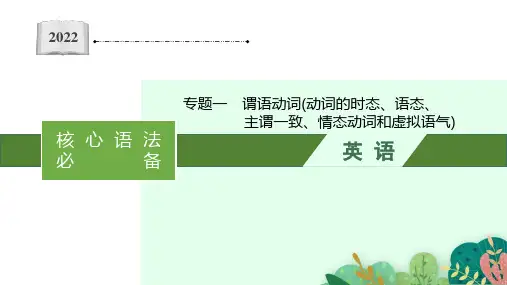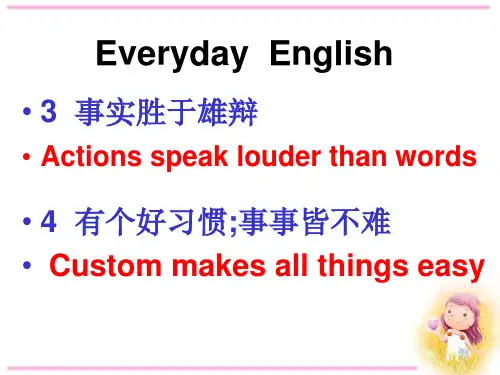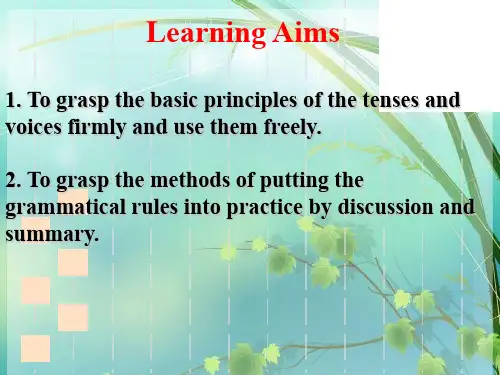- 1、下载文档前请自行甄别文档内容的完整性,平台不提供额外的编辑、内容补充、找答案等附加服务。
- 2、"仅部分预览"的文档,不可在线预览部分如存在完整性等问题,可反馈申请退款(可完整预览的文档不适用该条件!)。
- 3、如文档侵犯您的权益,请联系客服反馈,我们会尽快为您处理(人工客服工作时间:9:00-18:30)。
4.现在进行时可以表示现在不断发展变化的事 情。
It’s late Autumn. The weather is getting colder and colder.
Correct the sentence.
All the students here is belonging to No.1 Middle School. __b_e_lo_n_g__
When does the bus start? It starts in 2 minutes.
现在进行时(The Present Continuous Tense)
1) 表示现在这个时刻( 指说话时)正在发生的事 情。 We _a_r_e__h_a_v_in_g__ (have) English class now.
【注意】 一般情况下,下面4类动词无进行时态:
(1)表心理状态、情感的动词:like, love, hate, care, remember, believe, want, mind, wish, agree, mean, need。
(2) 表存在的状态动词:have, appear, exist, lie, remain, seem, belong to, depend on。
他在学校表现很好。(一般事实)
现在完成时(The present Perfect Tense)
English Basic Tenses () & Voices(语态)
时态和语态的主要考点
1、考查在语境中判断动词时态的运用能力。常考的 时态为:一般现在时、现在进行时、现在完成时、 现在完成进行时、一般将来时、一般过去时、 过去进行时、过去完成时、 过去将来时等。 2、时间、条件、让步等状语从句中动词的时态; 主从句时态呼应问题。
The geography teacher told us that the earth moved around the sun. _m__o_v_e_s_
2)表客观事实、普遍真理。 注意:主语为第三人称单数(he/she/it或单个
的人名、单个的事物名称)谓语动词+s/es, 其余人称作主语谓语动词用原形.
. 一般现在时 ( The Present Indefinite ) 1)表经常性、习惯性的动作或状态,常与表示
频率的时间状语连用,如always, often/
usually/frequently, sometimes, every…, at …,on
Sundays/….
Correct the sentence.
(3) 瞬间动词:begin/start, allow, accept, permit, promise, admit, complete。
(4)感官动词:see, hear, notice, feel, smell, sound, taste, look。
Tips:
现在进行时的标志: Now, right now, at this moment, look,
这个女孩老是在公共场所高谈阔论。
★进行时态与always, often/usually/ frequently/ constantly/all the time等频度副词 连用,表经常反复的行动或说话人赞叹或厌恶等 感情色彩 .
3) 现在进行时用来表示按计划即将发生的 动作,多用于位移/终止性动词,如: come, go, arrive, leave, stay, fly, take off. I__a_m__l_e_a_v_in_g__ (leave) tomorrow. _A_r_e__ you __st_a_y_i_n_g (stay) here till next week?
The shop will close at 9:00 p.m. _c_lo_s_e_s
3) 表示按计划、规定,时间表将要发生的动作 或存在的状态, 一般用于be, come, go, start, begin, leave, arrive, return等位移/终止性动词, 常与时间状语连用.
The train leaves at 6 tomorrow morning.
listen…
现在进行时和一般现在时的比较
①暂时性动作和经常性动作
The computer is working perfectly. 计算机运转得很好。(暂时)
The computer works perfectly. 计算机运转很好。(一直如此)
②持续性动作和短暂性动作
The bus is stopping. 车停了下来。(渐渐地) The bus stops. 车停了。(迅速)
③暂时性动作和永久性动作 She is living in the country.
她现在住在农村。(暂时) She lives in the country.
她住ቤተ መጻሕፍቲ ባይዱ农村。(永久)
④有感情色彩和没有感情色彩 He is doing well at school.
他在学校表现很好。(赞扬) He does well at school.
3、延续性动词和终止性动词的用法区别。 4、及物动词(vt.)的被动语态。 5、某些以主动形式表被动意义的动词的用法。
动词的时态 ( Tenses)
Fill in the blanks. I _s_t_u_d_y (study) hard abroad every day and I __g_e_t_ (get) along well with my roommates, but sometimes I _m__is_s_ (miss) my families.
2) 表示目前这段时间内正在进行的动作, 但说话时动作未必正在进行。 She __is__le_a_r_n_i_n_g_ (learn) piano under Mr. Smith at present.
Translate the sentence.
The girl is always talking loud in public.










